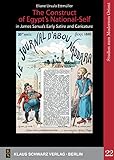The Construct of Egypt's National-Self in James Sanua's Early Satire and Caricature / Eliane Ursula Ettmüller.
Material type: TextSeries: Studies on Modern Orient ; 22Publisher: Berlin ; Boston : De Gruyter, [2020]Copyright date: ©2020Description: 1 online resource (328 p.)Content type:
TextSeries: Studies on Modern Orient ; 22Publisher: Berlin ; Boston : De Gruyter, [2020]Copyright date: ©2020Description: 1 online resource (328 p.)Content type: - 9783879974115
- 9783112208908
- 962.03092 22/ger
- PN5463.S3
- online - DeGruyter
- Issued also in print.
| Item type | Current library | Call number | URL | Status | Notes | Barcode | |
|---|---|---|---|---|---|---|---|
 eBook
eBook
|
Biblioteca "Angelicum" Pont. Univ. S.Tommaso d'Aquino Nuvola online | online - DeGruyter (Browse shelf(Opens below)) | Online access | Not for loan (Accesso limitato) | Accesso per gli utenti autorizzati / Access for authorized users | (dgr)9783112208908 |
Frontmatter -- Table of Contents -- Acknowledgements -- 1. Transliteration -- 2. Footnotes and Abbreviations -- 3. Introduction -- 4. The Self against the Other -- 5. Yaʿqub Ṣannuʿ -- 6. Content Analysis of Sanua’s Journals until the Beginning of the ʿUrābī Revolution -- 7. Final Conclusions -- Bibliography -- Appendix: Concise List of Sanua’s Journals from March 1878 until December 1881
restricted access online access with authorization star
http://purl.org/coar/access_right/c_16ec
Ya?qub Sannu? / James Sanua (1839–1912) was a pioneer in theater, satirical journalism and caricature. With the aim to foster nationalism in Egypt in the last third of the 19th century, he experimented with various literary genres. Deprived by the Khedive Isma?il of his career as a playwright, he started a satirical newspaper called 'Abu Nazzara Zarqa' (the man with the blue glasses) in 1878 which was forbidden after its 15th issue and its editor forced into exile. Based in Paris, Sanua continued to publish his magazine which was – according to his personal accounts – smuggled massively under adventurous circumstances into his home country where on 9 September 1881 Ahmad ?Urabi and his fellow officers ?Abd al-?Al Hilmi and ?Ali Fahmi made their march of protest to the ?Abidin palace. This popularly supported revolt was later recognized as the starting point of the first Egyptian nationalist revolution. This volume aims to disentangle the dichotomous construct which Sanua used in his satirical texts for the imagining of anEgyptian national identity. Until 9 September 1881 Sanua had published eight newspaper series and a total of 87 issues. His language and call for union, for resistance against oppression and for the fight against foreign invasion became increasingly more violent and religiously tinted. At the same time, his genres slowly transformed from his originally dramatic style proper for a playwright into a special kind of journalistic way of expression suitable for satirical magazines.
Issued also in print.
Mode of access: Internet via World Wide Web.
In English.
Description based on online resource; title from PDF title page (publisher's Web site, viewed 27. Jan 2023)


